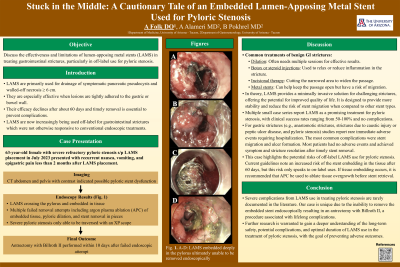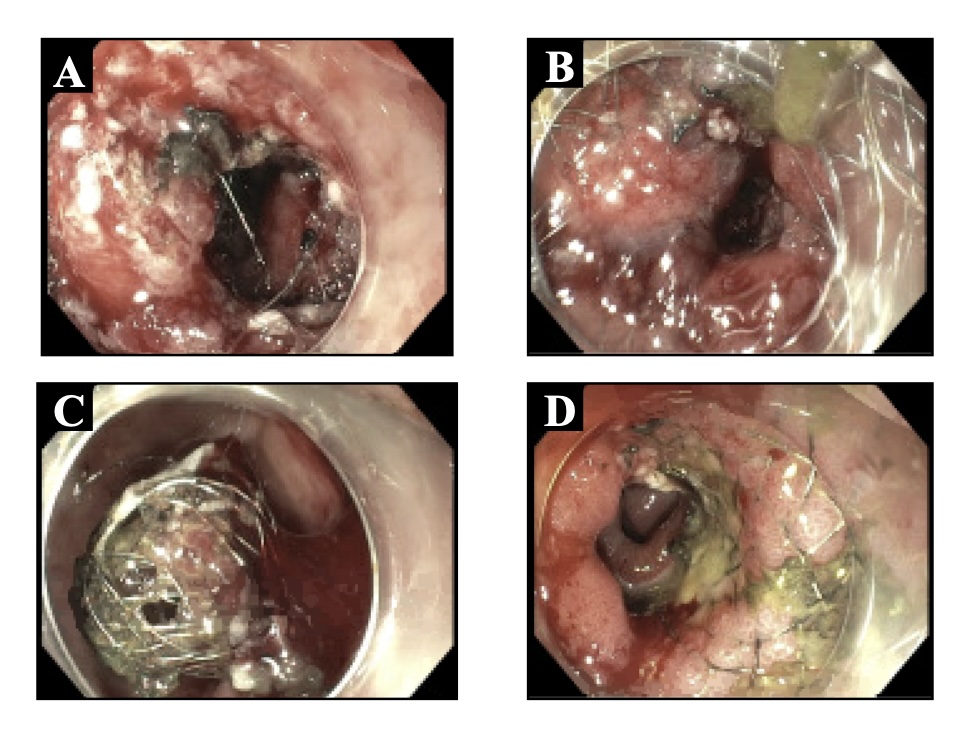Sunday Poster Session
Category: Interventional Endoscopy
P1083 - Stuck in the Middle: A Cautionary Tale of an Embedded Lumen-Apposing Metal Stent Used for Pyloric Stenosis
Sunday, October 27, 2024
3:30 PM - 7:00 PM ET
Location: Exhibit Hall E

Has Audio

Akira Folk, DO
Banner - University of Arizona
Tucson, AZ
Presenting Author(s)
Akira Folk, DO1, Aws Alameri, MD2, Bhupesh Pokhrel, MBBS1
1Banner - University of Arizona, Tucson, AZ; 2University of Arizona/ Banner Health, Tucson, AZ
Introduction: A lumen-apposing metal stent (LAMS) is utilized to facilitate the drainage of symptomatic pancreatic pseudocysts and walled-off necrosis measuring ≥ 6 cm, particularly when tightly adhered to the gastric or bowel wall. It is crucial to note that their efficacy tends to decline after approximately 60 days, underscoring the importance of timely removal. LAMS are also increasingly being used off-label for addressing gastrointestinal strictures that do not respond to conventional endoscopic interventions.
Case Description/Methods: We present a case of a 63-year-old female with a history of pyloric stenosis requiring LAMS placement who presented with recurrent nausea, vomiting, and epigastric pain. Within less than two months, the LAMS became deeply embedded in the pyloric tissue. Attempts to remove the stent using multiple methods, including argon plasma ablation and pyloric dilation, were unsuccessful. The stent was removed in small pieces, but remnants remained embedded within the pylorus, and the stenosis was so severe it could only be traversed with an XP scope. Ten days after endoscopic intervention, hepatobiliary surgeons performed an antrectomy with Billroth II reconstruction.
Discussion: This case emphasizes the significance of careful management and timely removal of LAMS, particularly when used off-label for gastrointestinal strictures. While LAMS are highly effective for draining pancreatic pseudocysts and walled-off necrosis, their utility diminishes after approximately 60 days, making timely intervention critical. This patient's experience highlights the potential complications of LAMS placement, including deep tissue embedding and severe gastrointestinal symptoms. Despite multiple endoscopic removal attempts, the embedded stent required complex surgical intervention, stressing the risks associated with off-label LAMS use for pyloric stenosis. This case serves as a cautionary example of the need for rigorous monitoring and early removal protocols to prevent adverse outcomes and highlights the potential necessity for surgical solutions when endoscopic methods fail. It also contributes to the expanding body of evidence on unusual complications associated with LAMS usage and underscores the need for further investigation into the appropriate duration of LAMS therapy.

Disclosures:
Akira Folk, DO1, Aws Alameri, MD2, Bhupesh Pokhrel, MBBS1. P1083 - Stuck in the Middle: A Cautionary Tale of an Embedded Lumen-Apposing Metal Stent Used for Pyloric Stenosis, ACG 2024 Annual Scientific Meeting Abstracts. Philadelphia, PA: American College of Gastroenterology.
1Banner - University of Arizona, Tucson, AZ; 2University of Arizona/ Banner Health, Tucson, AZ
Introduction: A lumen-apposing metal stent (LAMS) is utilized to facilitate the drainage of symptomatic pancreatic pseudocysts and walled-off necrosis measuring ≥ 6 cm, particularly when tightly adhered to the gastric or bowel wall. It is crucial to note that their efficacy tends to decline after approximately 60 days, underscoring the importance of timely removal. LAMS are also increasingly being used off-label for addressing gastrointestinal strictures that do not respond to conventional endoscopic interventions.
Case Description/Methods: We present a case of a 63-year-old female with a history of pyloric stenosis requiring LAMS placement who presented with recurrent nausea, vomiting, and epigastric pain. Within less than two months, the LAMS became deeply embedded in the pyloric tissue. Attempts to remove the stent using multiple methods, including argon plasma ablation and pyloric dilation, were unsuccessful. The stent was removed in small pieces, but remnants remained embedded within the pylorus, and the stenosis was so severe it could only be traversed with an XP scope. Ten days after endoscopic intervention, hepatobiliary surgeons performed an antrectomy with Billroth II reconstruction.
Discussion: This case emphasizes the significance of careful management and timely removal of LAMS, particularly when used off-label for gastrointestinal strictures. While LAMS are highly effective for draining pancreatic pseudocysts and walled-off necrosis, their utility diminishes after approximately 60 days, making timely intervention critical. This patient's experience highlights the potential complications of LAMS placement, including deep tissue embedding and severe gastrointestinal symptoms. Despite multiple endoscopic removal attempts, the embedded stent required complex surgical intervention, stressing the risks associated with off-label LAMS use for pyloric stenosis. This case serves as a cautionary example of the need for rigorous monitoring and early removal protocols to prevent adverse outcomes and highlights the potential necessity for surgical solutions when endoscopic methods fail. It also contributes to the expanding body of evidence on unusual complications associated with LAMS usage and underscores the need for further investigation into the appropriate duration of LAMS therapy.

Figure: Figure 1. A-D: Attempted endoscopic removal of a lumen-apposing metal stent embedded in the pylorus
Disclosures:
Akira Folk indicated no relevant financial relationships.
Aws Alameri indicated no relevant financial relationships.
Bhupesh Pokhrel indicated no relevant financial relationships.
Akira Folk, DO1, Aws Alameri, MD2, Bhupesh Pokhrel, MBBS1. P1083 - Stuck in the Middle: A Cautionary Tale of an Embedded Lumen-Apposing Metal Stent Used for Pyloric Stenosis, ACG 2024 Annual Scientific Meeting Abstracts. Philadelphia, PA: American College of Gastroenterology.
